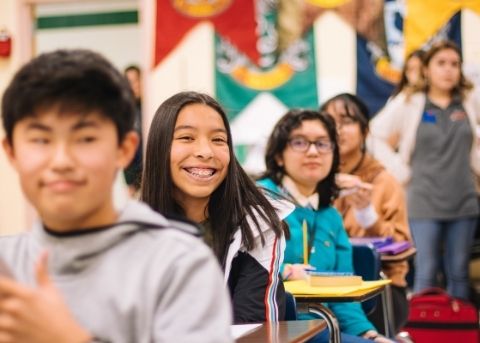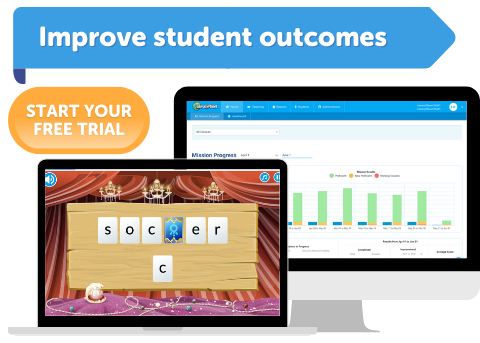Who out there is juggling a variety of personalities in their classroom? If you have more than one student, I’m guessing every teacher! Our backgrounds shape so much about who we are, how we participate in society and of course, how we learn. So when it comes to teaching literacy, it’s an important concept for us to remember—children will not learn the same way as others in their class.
Why are our backgrounds important to learning literacy?
 Universally, one thing children share is their differences. Within a class or a school, you’ll find a range of students who come from culturally diverse backgrounds, diverse family structures, living and socio-economic conditions and with many views on the importance of education on the development of a child.
Universally, one thing children share is their differences. Within a class or a school, you’ll find a range of students who come from culturally diverse backgrounds, diverse family structures, living and socio-economic conditions and with many views on the importance of education on the development of a child.
Literacy is the skill that will help children better understand the world around them. As they build their understanding, they can then communicate effectively, including being able to critically analyse the information they come across.
Children imagine what they hear or read and then apply what they’ve learned to their own experiences. From picturing a character’s identity to identifying with the character, how we teach literacy is really important.
Because our children have different interests and abilities, we need to adapt our teaching to suit their needs. Of course, children are a combination of all or some of these abilities, and combined with their background, are unique in how they comprehend and apply what they learn.
Aspects of a student’s background to be considered when teaching literacy
When we’re talking about background, what do we mean? It boils down to representation and feeling part of a community in which the student feels they belong and to which they relate. Here are a few key aspects that are handy to identify.
Socio-economic factors
Socio-economic constraints in the home will likely impact a student’s engagement with learning, access to educational resources and often, their aspirations. In the US, EdWeek Research Centre found that 56% of teachers, principals, and district leaders are somewhat or very concerned that the number of students experiencing homelessness will increase significantly during the current and next school years. And this study showed that 11% of respondents had fewer than 10 books in the home, limiting the child’s access to reading and developing literacy skills.
Socio-cultural factors
Worldwide, there are raised tensions among cultural and religious groups, including indigenous communities, who continue to fight for equality in access to education, among other things. There are migrant groups who also seek higher education standards for their children, having experienced war, famine, and ethnic prejudice in their former homes. Children who are at the centre of these conversations continue to suffer from poor representation and inclusion, leading in many instances to lower grades and literacy learning outcomes.
Many of these students are left behind by a system that has not caught up to diversity in teaching. In response to the 2020 racial debate in the US, 34% of teachers reported their school conducted some staff training on diversity, equity, and/or inclusion, which still leaves a significant gap in understanding students’ backgrounds and the impact on learning literacy. While recent research in Australia has shown rephrasing exam questions to give more appropriate cultural context can close the reading gap between indigenous and non-indigenous students by 50%.
Teacher bias
Most biases occur subconsciously. Prior experiences can influence our thinking and actions. Knowing students with certain backgrounds are more vulnerable to being left behind, or assuming they are unable to apply contextual meaning to teaching, is a form of bias. This study into teacher expectations and academic outcomes found that teachers’ expectations for students in reading were significantly higher than actual achievement. We are aiming for accuracy and consistency in assessing literacy learning progression. Being aware of your students’ background and using it to your teaching advantage will achieve this.
How to take a student’s background into account when teaching literacy
Knowing the impact a child’s background has on how they learn literacy concepts, we’ve gathered some strategies for taking into account a student’s background when teaching literacy.
Complete your own research
Do a little review of your class—consider cultural background, immigrant status, family make-up, religion, languages spoken at home etc. Then ensure you are informed of these backgrounds in a practical sense. If you experienced lockdowns during the pandemic, this may have been a great opportunity to garner more insight into your students!
Assign appropriate tasks
Assign tasks that allow students to apply their own contexts. You are looking to teach with relatable content in your classroom to draw your students in. Including content that is personal and relevant to their real world and what they’re interested in will assist this. Also, celebrate the differences in your class! Give students a range of texts to read and work on and give them texts that really extend their understanding beyond their cultural background. This helps them to relate to their peers and the world around them.
Think outside the textbook
Use other subjects such as art, music, and physical education to enable students to learn literacy in a manner that best relates to their interests and abilities. More information about doing this can be found here. You may also choose to use varying forms of media including audiobooks as a way to improve literacy outcomes. The benefits of which are outlined in this study. Further, encourage storytelling in classwork so that you can observe what makes each student tick and offer them the opportunity to build literacy skills in a more comfortable way.
Engage the family or wider community
The wider community’s impact on a child’s ability and interest in learning literacy cannot be underestimated. The family unit and greater cultural setting can support or influence the development of literacy skills through engaging with the child in storytelling, contextual meaning, and going over lessons and ideas.
Ensure equitable access to resources
When allocating tasks to your students, wherever possible, ensure every student has access to the resources they need to complete tasks, without drawing attention to any resource deficit.
Develop playgroups
For younger children in their formative years, the playgroup has also proven to be a wonderful setting for achieving learning outcomes among disadvantaged children. Through relating to others’ circumstances and being on equal footing, they feel safer and are encouraged to perform.
Apply Passion-led teaching
Your background matters too! Find an interest in the subject area you are teaching. Your enthusiasm and genuine care for the content will show through. Take this content and emphasise it in a manner that you know also interests your students. Great teachers absorb their students’ interest and enthusiasm. What the student thinks is relevant becomes important to the teacher.
Employ diverse teaching staff
A whole-of-school strategy should also be to employ a diverse staff. Children thrive when they are able to apply context and feel represented in their education. The teaching staff should represent the diversity of the student population.
Use LiteracyPlanet in your literacy teaching
 The LiteracyPlanet content is designed to appeal to each one of the different students in your classroom. From extension and intervention strategies to gamified and competition elements, rewards and recognition, to learning levels set to the individual’s need. It’s a fun and safe environment in which every student can learn at their own pace, on their own journey. It’s also a brilliant tool for students studying English as their second language.
The LiteracyPlanet content is designed to appeal to each one of the different students in your classroom. From extension and intervention strategies to gamified and competition elements, rewards and recognition, to learning levels set to the individual’s need. It’s a fun and safe environment in which every student can learn at their own pace, on their own journey. It’s also a brilliant tool for students studying English as their second language.
To allow students to form stronger understandings of their world, as they know it, and as they build it, educators must have a deeper appreciation for their students’ backgrounds as they deliver literacy lessons. And when students feel socially and culturally represented in their education, they will take their learnings and make more meaningful contributions to society. We’d love to hear what strategies you’ve employed in your classroom to be inclusive!






